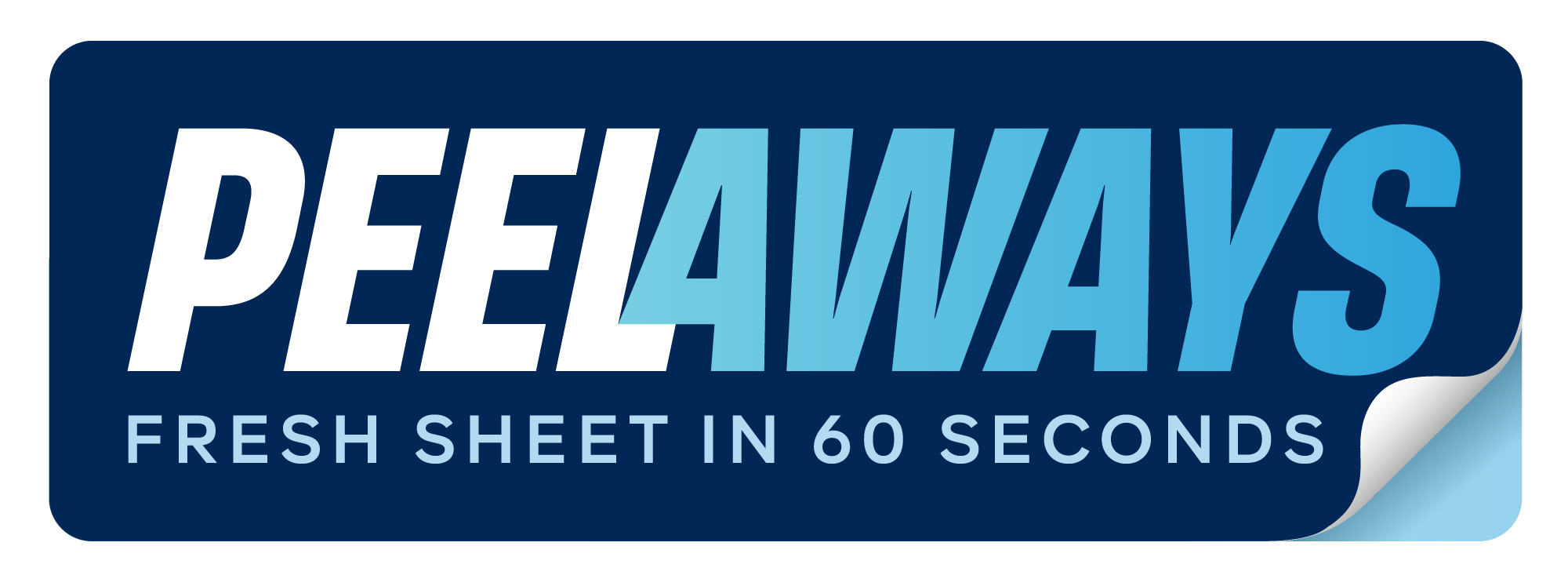How to Prevent Cross-Contamination in Bedding

Cross-contamination in bedding can pose serious health risks, especially in healthcare settings or homes with vulnerable individuals. The key to preventing this is proper handling, storage, and cleaning of linens. Here’s what you need to know:
- Soiled linens should be handled with gloves, rolled inward to contain debris, and placed in leak-proof bags.
- Clean bedding must be handled carefully to avoid contact with contaminated surfaces.
- High-temperature laundering (at least 160°F) and EPA-approved disinfectants are essential for killing pathogens.
- Storage and transport should ensure clean and soiled linens remain separate, with proper disinfection of transport containers.
- Multi-layer disposable bedding, like PeelAways, simplifies the process by letting you remove only the top layer, reducing handling and contamination risks.
Removing Linen
What Causes Cross-Contamination in Bedding
Improper storage of soiled linens is a major factor in the spread of pathogens. When dirty bedding is left uncontained, it can transfer harmful microbes to the surrounding environment and even to clean linens [1][2].
Unsealed linens pose another risk - they can leak fluids, potentially contaminating fresh items nearby. Even a brief interaction between soiled and clean bedding can compromise hygiene standards.
This underscores the need for secure storage practices. Properly storing used linens helps disrupt the contamination cycle and plays a key role in maintaining overall bedding cleanliness. Solutions like PeelAways' multi-layer disposable bedding offer a practical way to minimize handling and reduce cross-contamination risks during storage, contributing to better hygiene.
Focusing on safe storage practices lays the groundwork for effective bedding handling and replacement routines.
Step-by-Step Guide to Safe Bedding Changes
Changing bedding safely is crucial for protecting both caregivers and patients from harmful pathogens. This process involves three main phases: handling soiled materials, replacing bedding without contamination, and proper disposal or laundering. Here's how to do it step by step.
How to Handle Soiled Bedding
Before touching soiled bedding, always wear personal protective equipment (PPE), such as gloves and gowns. This creates a barrier against pathogens [3][4]. Avoid shaking the bedding, as this can release contaminated particles into the air [1]. Instead, carefully roll the linens inward to contain debris and fluids.
Once rolled, place the soiled bedding directly into leak-proof, labeled bags designed for contaminated materials [3][4]. Keep handling to a minimum at the bedside to reduce exposure risks.
How to Replace Bedding Safely
After securing the soiled linens, focus on replacing the bedding without introducing contaminants. If the mattress or bed frame is visibly soiled, disinfect them thoroughly before adding clean linens [1]. Handle clean bedding with freshly washed or gloved hands, and make sure it doesn’t touch the floor or any contaminated surfaces [3][4].
For a more efficient process, consider products like PeelAways. These allow caregivers to simply peel away the soiled layer, instantly revealing a clean sheet underneath. This eliminates the need to lift mattresses or handle full sets of linens, reducing both time and exposure to contaminants.
Throughout the process, use clearly marked containers to separate clean and soiled linens. A color-coded system - like red for contaminated items and blue or green for clean materials - can help prevent accidental mixing.
How to Dispose or Launder Soiled Bedding
Once the clean bedding is in place, promptly handle the soiled linens to complete the process. Transport them in sealed, leak-proof, and labeled containers [3][4]. Avoid moving contaminated linens through clean areas or placing the bags on clean surfaces.
For laundering, use high-temperature wash cycles of at least 160°F with suitable detergents and disinfectants [3][4]. This temperature is effective in killing pathogens, while the combination of heat, detergent, and agitation ensures thorough cleaning. After washing, disinfect the machines using EPA-approved disinfectants that are compatible with your equipment to prevent cross-contamination [3].
Heavily soiled or single-use bedding should go directly into designated waste containers. Follow local regulations for disposing of medical or biohazardous waste, especially when dealing with linens contaminated by bodily fluids or infectious materials [3][4]. Products like PeelAways simplify this step by allowing you to discard only the soiled layer, leaving the other layers intact.
Finally, once everything is complete, remove your PPE and wash your hands thoroughly before handling any clean bedding [3].
sbb-itb-45288fe
Storage and Transport Best Practices
Adopting strict storage and transport protocols is key to avoiding cross-contamination. Even the most meticulous linen handling can fall short if clean and soiled items mix during storage or transit. A structured system that safeguards both the materials and the people handling them is a must.
How to Separate Clean and Soiled Linens
Keep clean and soiled linens physically separated in designated areas with controlled air pressure and proper filtration systems [6]. Clean linen storage spaces should maintain these controls to help ensure a hygienic environment [6].
To protect clean linens from contaminants like dust, debris, and moisture, avoid storing them near open windows, louvers, or dock doors [6]. Freshly laundered linens should be bagged in plastic or covered to prevent airborne contamination during storage and transport [1]. If wire racks are used, the bottom shelf should either be solid, lined with a barrier, or hold items in sealed containers [6].
Access to clean linens should be restricted to authorized personnel, with storage areas monitored or controlled by healthcare staff [6]. A first-in, first-out rotation system is also recommended to maintain hygiene.
Products like PeelAways offer a practical solution by incorporating multiple clean layers into a single item, reducing the need for extra storage without compromising contamination prevention. Beyond storage, container hygiene is critical to maintaining these standards.
How to Disinfect Transport Containers
Once clean and soiled linens are separated, the next step is disinfecting transport containers to avoid cross-contamination. Containers designated for soiled linens should be cleaned and disinfected after every use [2].
Carts used for transporting soiled textiles can follow manual or automated cleaning protocols, using EPA-registered disinfectants at the correct dilution and contact times [6]. Timing matters - carts should be cleaned after each use, not just when visibly dirty [6]. While carts for clean linens are typically cleaned daily with neutral detergent and warm water [2], those for soiled linens often require more rigorous cleaning.
It’s also essential to keep transport carts within the facility’s controlled environment [6]. Taking them outside exposes them to unregulated contaminants that can compromise the entire system.
Before being loaded with freshly laundered linens, carts or hampers must be cleaned to prevent contamination from previous use [5]. For multi-layered products like PeelAways, peeling away the soiled layer reduces the risk of container contamination, but all containers used for disposing of these layers must still meet strict hygiene standards.
Real-world lapses in container disinfection have shown how quickly contamination can escalate [6], underscoring the importance of maintaining these protocols at every step.
Product Features That Reduce Cross-Contamination
The right bedding products can be the difference between maintaining a clean, safe environment and dealing with contamination incidents. Some products are designed to actively prevent cross-contamination rather than merely addressing it after it occurs. Below, we’ll dive into how these features enhance safety while simplifying the process for caregivers.
Advantages of Multi-Layer Disposable Bedding
Multi-layer disposable bedding eliminates many of the high-risk steps involved in traditional bedding changes. Take PeelAways, for example. Their patented peel-away design includes 5 to 7 absorbent layers, depending on the size. When contamination happens, caregivers simply peel away the soiled layer to reveal a fresh, clean sheet underneath - no extra effort required.
Here’s why this design is a game-changer:
- No mattress lifting: Prevents the spread of airborne contaminants.
- Minimized handling: Reduces the need to transport soiled linens.
- Less direct contact: Decreases exposure to contaminated materials.
- Fewer contamination opportunities: Simplifies collection, transport, and cleaning processes.
This system is especially valuable in high-risk settings like elder care, medical recovery, and special needs environments. In facilities with multiple beds, it not only saves time but also lowers the overall risk of contamination. PeelAways offers Cot and Twin XL sizes with 7 layers, while standard sizes like Twin, Full, Queen, and King come with 5 layers to meet both household and healthcare needs.
Beyond the multi-layer design, the materials used play a critical role in maintaining a safe and comfortable environment.
Waterproof and Breathable Materials
The combination of waterproof and breathable materials is essential for preventing fluid penetration while ensuring comfort. A 100% waterproof barrier stops fluids from reaching the mattress or underlying layers, effectively halting contamination at its source.
PeelAways achieves this balance by pairing waterproof functionality with soft, breathable fabric. This design prevents heat and moisture buildup, which can lead to skin irritation or even bacterial growth. By allowing steady air circulation, the bedding remains comfortable without compromising its protective barrier.
Another important feature is the use of chemical-free materials. Unlike some bedding products that rely on chemical treatments - potentially causing allergic reactions or irritation - PeelAways opts for safer alternatives. This makes the bedding suitable for individuals with sensitive skin or weakened immune systems, ensuring protection without added risks.
Comfort isn’t overlooked either. Rough or abrasive materials can lead to skin issues, creating entry points for infections. PeelAways’ soft fabric construction ensures that infection control measures don’t come at the cost of comfort, making it an ideal choice for both protection and healing.
Proper maintenance is key to getting the most out of these features.
When to Inspect and Replace Bedding
Establishing a regular inspection routine is crucial for maintaining safety. Even the most advanced bedding systems need to be monitored to ensure they continue providing effective protection.
For multi-layer disposable bedding, check each layer for any signs of damage, such as tears, punctures, or separation, which could compromise the waterproof barrier. If any issues are found, replace the layer immediately to maintain protection.
In high-risk environments, more frequent inspections are recommended, while in lower-risk settings, a routine schedule may suffice. For traditional bedding, damaged or worn items should be removed from use right away, as even minor issues can quickly lead to major contamination risks. Staying proactive with replacements helps maintain hygiene standards and ensures a safer environment for everyone.
Conclusion: Better Hygiene with Smart Bedding Solutions
By following proper protocols for handling, storage, and inspection, you can maintain a higher level of hygiene in caregiving environments. Key practices - like safely removing soiled bedding, ensuring proper hand hygiene, using separate storage systems, and conducting regular inspections - work together to create strong defenses against contamination.
PeelAways offers a practical solution that simplifies bedding changes while reducing contamination risks. Instead of lifting heavy mattresses or managing full sets of linens, caregivers can simply peel away the soiled layer to reveal a fresh, clean sheet underneath. This process not only minimizes handling but also reduces the need for immediate laundering, cutting down on direct exposure to contaminants.
Additionally, the waterproof barrier and chemical-free materials used in PeelAways provide an extra layer of safety, making them ideal for sensitive care environments. Whether you're caring for elderly individuals, supporting those with special needs, or assisting in medical recovery, this combination of protection and comfort helps make daily care safer and more manageable.
FAQs
How can I prevent cross-contamination when changing bedding in a healthcare setting?
To reduce the risk of cross-contamination during bedding changes in healthcare settings, always begin by putting on gloves and thoroughly washing or sanitizing your hands both before and after handling linens. When dealing with soiled bedding, handle it gently - avoid shaking or disturbing it, as this can release contaminants into the air. Use clearly marked carts or containers specifically for dirty linens, keeping them strictly separated from clean items.
It's equally important to sanitize any surfaces or equipment used during the process. This extra step helps minimize the spread of harmful microorganisms, ensuring a safer and cleaner environment for both patients and healthcare staff.
How can PeelAways multi-layer disposable bedding help prevent cross-contamination?
PeelAways multi-layer disposable bedding offers a practical way to reduce cross-contamination. With its unique design, you can simply peel away the soiled top layer, revealing a fresh, untouched layer beneath - no need to disturb the clean layers underneath. This feature helps minimize the spread of germs and bacteria effectively.
What’s more, PeelAways eliminates the hassle of lifting mattresses or dealing with laundry. It streamlines the bedding change process, making it a hygienic and convenient option for environments where cleanliness is a top priority.
How can I store and transport clean and soiled linens to ensure hygiene is maintained?
To keep linens hygienic, store them in a clean, well-ventilated space specifically set aside for this purpose. Make sure the area is free from possible contaminants. Use shelves that are easy to clean, and cover the linens to shield them from dust and other particles.
When moving linens, rely on dedicated carts or containers that are regularly cleaned and sanitized. Handle soiled linens carefully by placing them in sealed or covered bags to avoid direct contact and reduce the risk of cross-contamination. Limiting how often linens are handled and ensuring good air circulation in storage areas are also important steps to maintain their cleanliness.
Related Blog Posts
- Disposable vs. Washable Bed Sheets: Comparison
- 5 Steps for Handling Contaminated Linens Safely
- How Disposable Sheets Reduce Cross-Contamination
- FAQs About Anti-Slip Bedding for Patients
Comments
0

SAVE MONEY & WATER
Professionals & Institutions save a fortune on labor/laundry.

SUPERIOR COMFORT
The first thing our customers notice is how soft our sheets are.

100% WATERPROOF
Each layer is 100% Waterproof, perfect for spills and accidents

SAVE TIME
Change the sheet in under 1 minute without stripping the bed.




Leave a comment